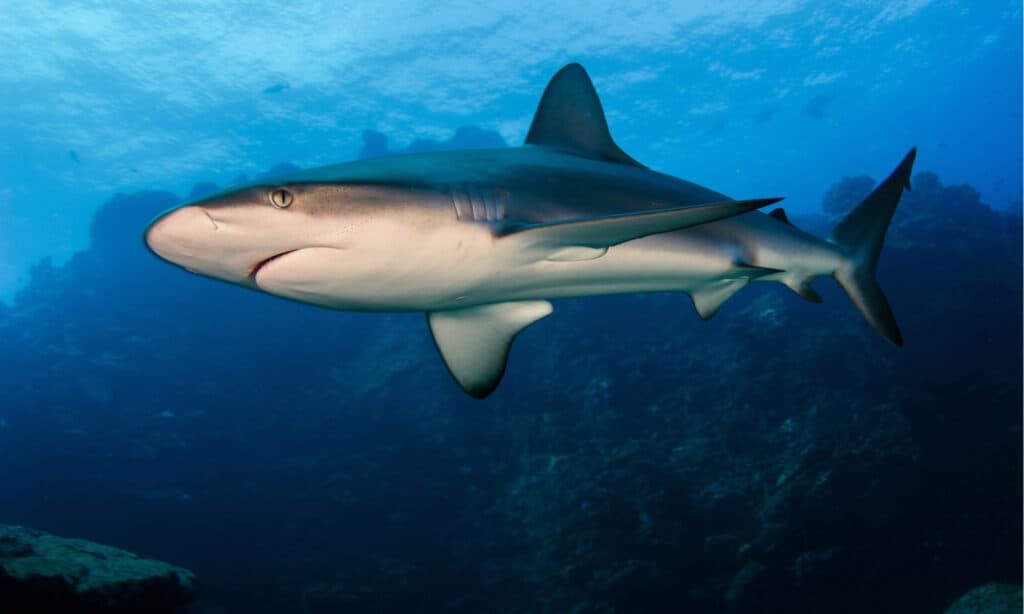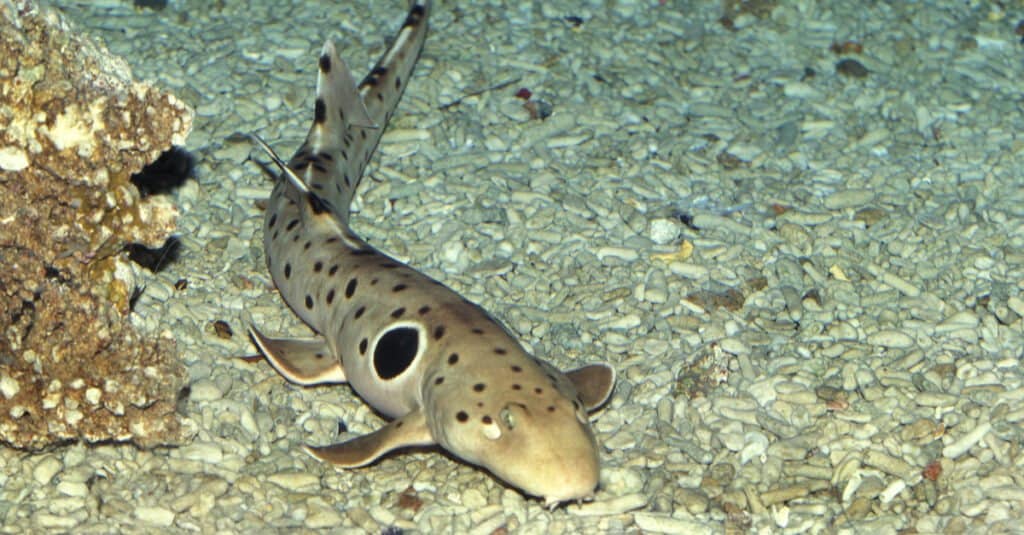Sharks are one of the colossal creatures that nature has bestowed upon us in the ocean. Like other aquatic creatures, sharks have a streamlined physique that allows them to move quickly. Like the great white shark, some species utilize their tails to drive themselves through the water, while others move their bodies from side to side and rely on their fins for balance. Their body shape determines the pace with which they move, which extends from cruisers, wrigglers, generalists, floaters, and undulators to the flappers.
Many people ask if this massive marine creature can move backward in style. In this article, we’ll find out if sharks can swim backwards.
Can Sharks Swim Backward?

Due to the shape of their fins, sharks can’t swim backward.
©Tomas Kotouc/Shutterstock.com
Sharks cannot swim backward, courtesy of the shape of their fins, which prevents them from stirring up sediment while swimming and makes it difficult for them to slow down as they approach the seafloor. Another valid reason that buttresses why sharks can’t swim backward lies with the inability of their pectoral fins to curve upward like other fishes, which, by default, limits their swimming ability to only forward motion.
Intriguingly, when a shark wishes to tilt backward, it must unconditionally depend on the force of gravity. And sadly, any backward movements from the shark makes it susceptible to water entering its gills, which consequently interferes with the respiratory process and ultimately results in death. Several anglers who have successfully had to kill sharks over the years used their inability to swim back to their advantage by dragging them out of the water with their back to the shore level.
Can a Shark Walk?

Epaulette sharks may walk on land.
©slowmotiongli/Shutterstock.com
It is no news that sharks, as the only fish species that cannot swim backward, despite their streamlined bodies, are unable to come to a complete stop or swim backward because their pectoral fins can’t fold upwards like other fish’s. Nevertheless, some sharks, such as those found in Australia (epaulette sharks), may ‘walk’ backward on land; however, this depends only on gravity. Rather than swim, this species of long-tailed carpet shark found mostly in shallow, tropical waters off Australia and New Guinea wriggle their bodies with their pectoral and pelvic fins to move across the ocean’s floor.
What Happens if Sharks Swim Backward?
Sharks can only swim forward to maintain their default breathing as water rushes through their open mouths and out of their gills, where gas exchange occurs. Unfortunately, when sharks swim against their natural forward movement, a handful of water gets into the gills, which consequently causes them to drown.
Can Sharks Suddenly Stop Swimming?

In order to maintain the oxygen-rich flow of water over their gills, sharks must swim continuously.
©iStock.com/Alessandro De Maddalena
Sharks’ capacity to freely travel up and down in the water column is one of the most remarkable adaptations they’ve had over time. However, their cartilaginous structure allows them to make rapid ascents and descents without being harmed. Interestingly, these marine creatures have successfully adopted a few methods to keep them breathing while still in the water.
Some sharks must swim continuously to maintain the oxygen-rich flow of water over their gills. In contrast, others may use their pharynx to pump water through their respiratory system. Unfortunately, when sharks do not swim, they are likely to sink to the bottom of the water column. However, several sharks can pump oxygen-rich water over their gills without swimming, such as the nurse shark.
How Do Sharks Swim?
Their body type and species determine sharks’ swimming style. They have evolved a streamlined physique that allows them to move effortlessly in the ocean for millions of years. Sharks can swim in various ways, including floating, flapping, cruising, undulating, and wriggling. These large aquatic animals use their tails to propel their bodies forward. Indeed, we can say that shark tails play a critical part in their movement in the marine world.
Do Sharks Die if they Stop Swimming?
It’s a common myth that sharks die if they stop swimming. This idea has already been disproved by the nurse shark and the tiger shark, which, along with a few other shark species, can stop swimming abruptly.
Buccal pumping, which some sharks adapt, is actively “inhaling” water by drawing it into the mouth and across the gills with cheek muscles. Interestingly, a few sharks with this unique adaptation can cease moving while still breathing. When their mouths are covered, they can relax on the ocean floor and even partially bury themselves in the sand, using spiracles, or respiratory apertures behind the eyes, to draw water through their gills. Some shark species like great white sharks, whale sharks, hammerheads, and mako sharks, on the other hand, do not have the abilities for buccal pumping. These sharks depend on obligate ram ventilation, which compels them to swim with their open mouths and push water through their gills. If more water isn’t pushed through their gills as they swim, they will run out of oxygen and die.
Can a Shark Sleep?
Sharks are thought never to sleep since they must move to stay alive. Sharks can engage in deep rest while their spiracles continue to push water over their gills, but it’s not the same as the sleep that most animals enjoy. Intriguingly, sharks do not have eyelids, and their eyes remain wide open to monitor the movement of other sea creatures and prey moving around them. Unlike other sharks, the whitetip reef shark, Caribbean reef shark, nurse shark, wobbegong, and lemon shark are all capable of sleeping in their stationary state during the day.
Can Sharks Turn Around?
Sharks almost always swim in a straight line when you see them, and they rarely deviate from their forward movement. Naturally, this may make one wonder if the sea creatures can turn around. Well, yes, sharks can turn around. These marine animals can practically reach for their tail in a swift circular motion, courtesy of their cartilaginous body frames instead of bony structures. Their fin arrangements also help them maneuver at high speeds, give sudden stops, and effortlessly help them turn in all directions.
The photo featured at the top of this post is © iStock.com/atese
Thank you for reading! Have some feedback for us? Contact the AZ Animals editorial team.






